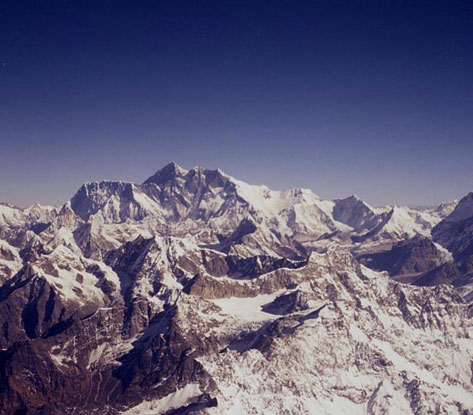| Constraining the Architecture of Active Thrust Systems |
 |
Project Summary
Personnel: Cam Wobus (Ph.D.) Kip Hodges (Ph.D.) Despite many recent advances in our understanding of the tectonic evolution of the Himalaya, perhaps the quintessential collisional orogen, some important controversies remain. One of these centers on the relationship between the dramatic topographic transition separating the high Himalayan peaks from their foothills and the major deformational structures that underlie it. This controversy is fueled in part by the geographic near-coincidence of the trace of the Main Central Thrust (MCT) system with the topographic front. Although the MCT has long been considered dormant by most Himalayan geologists, a number of observations require continued differential uplift and exhumation of the Higher Himalaya and suggest to some an active role of the MCT: (1) crystalline rocks in the hanging wall of the MCT have been the dominant source of sediment delivered to Bengal fan since at least 17Ma (France-Lanord et al., 1993); (2) microseismicity clusters on a linear trend that coincides with both the topographic transition (Pandey et al., 1995) and the mapped trace of the MCT (Colchen et al., 1986); (3) recent geodetic studies indicate rapid differential uplift of the Higher Himalaya (Jackson and Bilham, 1994; Bilham et al., 1997); and (4) late Miocene-Pliocene 40Ar/39Ar cooling ages and Th-Pb monazite ages indicate recent deep exhumation and synkinematic metamorphism in MCT zone, respectively (McFarlane et al., 1992; Harrison et al., 1997). Three alternative models with fundamentally different tectonic implications have been advanced to explain the topographic transition: (1) erosional retreat following Miocene activity on the MCT (Masek et al., 1994); (2) fault-bend fold deformation above a crustal-scale ramp in the Himalayan Sole Thrust (HST) (e.g., Lyon-Caen and Molnar, 1983; Bilham et al, 1997); and (3) recent (Pliocene) (Harrison et al., 1997) or active thrusting on the MCT (Seeber and Gornitz, 1983). Determining whether the foothills-Higher Himalaya transition is a transient erosional front, the topographic signature of a subsurface ramp, or the trace of an active fault system is critical if we are to understand how the Himalayan orogenic wedge has evolved over the Miocene-Recent interval. Each model predicts distinctive spatial patterns and timing of uplift and exhumation that can be exploited to evaluate their relative merits. We propose to test among these models through a multi-disciplinary study, combining structural mapping, tectonic geomorphology, and topical 40Ar/39Ar and (U-Th)/He geochronology to explore the structural and thermal evolution of the foothills-Higher Himalaya transition in two readily accessible areas: the Burhi Gandaki and Trisuli drainages of central Nepal. The proposed combination of geomorphic and geochronologic approaches will provide several independent measures of late Miocene to recent uplift and exhumation patterns -- independent of available geodetic and microseismic data currently used to constrain crustal architecture - and thus help inform the next generation of evolutionary models for the Himalayan orogenic wedge. |